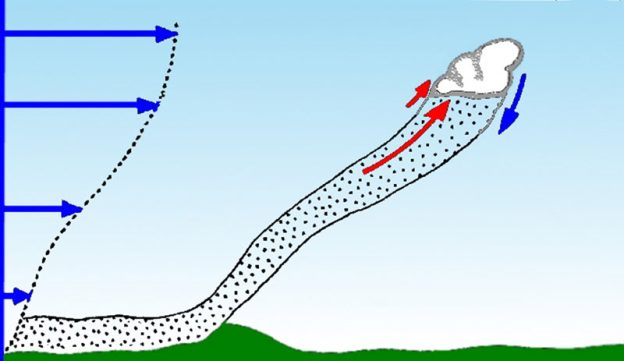We all like a light to moderate wind day because it’s beneficial for the generation of thermals and it’s relatively predictable. On strong wind days though, we tend to leave the hangar doors closed because they break the thermals up and can be harder to find, especially near the ground! The good thing is that even on these days, the hot air still sticks to the ground as they move downwind during the growing process. Finally, an obstacle is encountered, and the thermal separation from the surface. What is this obstacle? It can be a group of trees or tree line, a farmhouse, a cool dam, vegetation change, neighboring scrub, a car driving down a country road, or even a change in slope. (Editors note: I recall my grandfather telling a story of his imminent outlanding in a new Ka-6 when flying over a field with a tractor plowing it. The moving tractor helped separated the warm air from the ground allowing a thermal to take him away.)
Thermal Genisis
The warm air is continually being pooled and continues to be pushed along the ground, drawing it in, and feeding the thermal, even after the thermal has fully established itself. Under the center of the thermal, a lower pressure is developing with a positive side effect. It causes more warm air to be sucked off the ground along the thermal path of the ever-so-gradually shrinking hot air reservoir, prolonging the life of the thermal on windy days. What does this mean? Simply, we may be wasting our time looking for thermals overhead the trigger source as we would normally do on light wind or calm days. Basically, we must look downwind of the trigger point!
Leaning Thermals
For sure there’s no disputing that thermals drift over the ground in relatively flat terrain. In mountainous terrain, well, that’s another story and not my specialty, but the trigger source and thermal will remain relatively stationary. What happens over the flatlands though? As you’ve probably seen, clouds drift, always in the direction of the upper wind! So do thermals lean over or do they drift downwind in a vertical column?
Drifting Thermals
Personally from my experience, thermals drift downwind in a vertical column of air, rather than lean. Thermals also seem to generate from the same position on a semi-regular basis too in this situation. But older clouds downwind don’t dissipate? This is usually because they are drawing in air from nearby decaying clouds or still have warm air feeding them in general. To support the vertical column of air theory rather than a leaning thermal is that when you join a gaggle of gliders, you’ll often join them from immediately below or above them, even on moderate to strong wind days and thousands of feet apart from the already established glider.
On windy days, it takes some practice to find thermals quickly without wasting too much time. It’s useful to always look down to try to find the trigger source when low, from around 2-3000’ AGL, as there’s less ambiguity around where the thermal came from, the higher up the more imagination you need! Once you are able to identify where the thermals are coming from, you’re able to fly from one thermal source to another, greatly increasing your chances of finding lift, then centering quickly to stay in it. Soon this process or thermal finding ability will become subconscious, and our success rate in finding thermals on windy days will increase, resulting in more motivation and enjoyment for our wonderful sport – life’s good. 🙂 Source: ‚Adam Woolley on Wings & Wheels‚. Grafik: ‚Segelfliegen, Grundausbildung‘.


